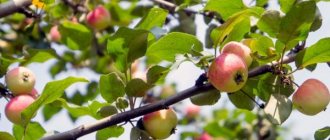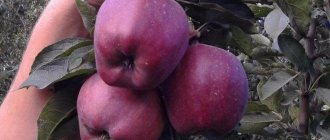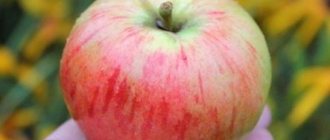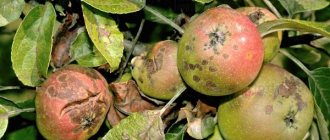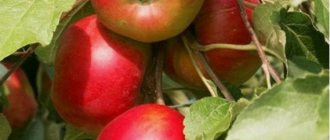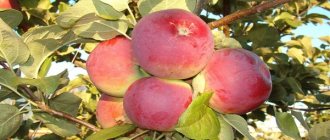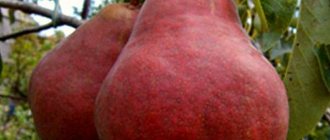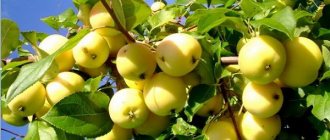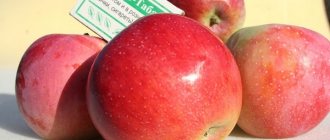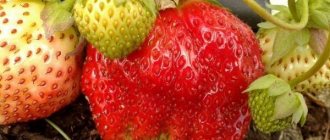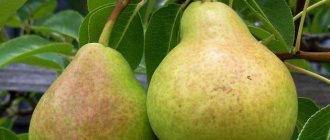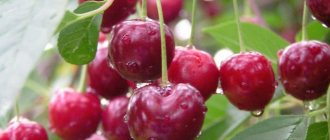Description, photo
The Fuji apple tree was obtained by Japanese gardeners in the region after which it is named, Fujisaki, as a result of crossing the Rolls Janet and Red Delicious varieties.
The result was a tree of indescribable beauty and exquisite, super-sweet fruits. The variety tolerates frosty winters and hot, dry summers.
Fuji apples are very popular and in demand around the world.
Attention! In China, 80% of all apples grown (approximately 10 million tons) are Fuji fruits and its clones.
The tree belongs to winter varieties with a long shelf life (following storage rules, the fruits are well preserved until the end of May ).
Thanks to the hard peel and dense sweet pulp, even after heat treatment, the fruits do not lose their taste and retain their structure well in baked goods. Therefore, confectioners and cooks, ordinary consumers give their preference to this variety of apples.
History of selection of the Japanese variety
The Japanese apple variety is popular not only among domestic gardeners, but also in many other countries around the world. However, it originally appeared in the province of Fujisaka.
Fuji tree
Local breeders developed a new species and named it after the area where it appeared. The Fuji apple variety owes its appearance to two others - Red Delicious and Rolls Janet. He received only the most useful characteristics from his “parents”. The tree itself has a beautiful shape, and the fruits are juicy and tasty.
Interesting information. This variety is often called fushi apples. In Russia, both options can be considered correct.
Reviews
Evgeniy, Penza region. “I want to share my impressions of Fuji apples. You can't imagine anything tastier than apples. Everyone knows this variety, so after a long search, we finally planted this miracle on our site. Knowing that dwarf trees begin to bear fruit earlier, we looked for a tree on a dwarf rootstock. The first fruits were collected the next year, there were only 5 of them, but the taste was amazing (100 times better than store-bought ones), and the smell was the aroma of warm autumn throughout the cold winter. Now we will look for its varieties.”
Stepan, Saratov. “When planting an orchard, I chose (having received information from the Internet and read reviews from there) the Fuji, Fuji Kiku apple trees and also found the Fuji Beni Shogun variety. My impressions: the apple trees did not disappoint. The fruits are tasty and beautiful. They have become the most beloved of all those in the garden. There is only one drawback: as for me, the harvest is not enough, I would like more. And so – the apples are sweet, juicy, crispy. They are stored for a long time and without problems. Before storing it, I do not treat it with anything, which is important, there are no unnecessary chemicals. We eat our last apples even at the beginning of spring.
Trees are also not capricious in caring for them, in principle, like others: watering, spraying against pests and diseases, I don’t forget about fertilizing, but I prefer foliar treatments, combining them with chemical treatments. The trees are not tall, so pruning and harvesting are very convenient. I recommend everyone to plant this variety, I’m sure you’ll like it.”
Irina, Belgorod region. “I tried Fuji apples, bought them at the supermarket, and fell in love with the first bite. I tortured my husband until he found him on online shopping sites and ordered him out. We planted two Fuji and Fuji Kiku trees. Our own fruits are even tastier than store-bought ones - juicy and very pleasant to the taste. But, unfortunately, we will get rid of the Fuji variety; compared to Fuji, Kiku loses in taste. After reading about it on the Internet, we realized that it lacks sun in our area (I live in the Belgorod region). Instead, we will try to find other varieties of the variety, fortunately the breeding work did not stop at just Fuji, there is plenty to choose from: Red Fuji, Yataka, Kiku-8 and others.”
Galina, Kirov. “I would classify this variety as one of the apple “elite” - for me the best. I was captivated by the delicate taste and aroma, but the juiciness of the apples is a whole different story. Moreover, after long storage (end of winter) they remain just as strong and the juice in the fruits does not decrease. They’re very good in baking and don’t turn into mush.”
Recommendations for planting Fuji apples and caring for the variety
In the southern regions of the country there are no problems with growing seedlings; there is always enough sun there. But for other gardeners it is useful to know where it is better to plant a tree.
The apple tree of this variety prefers to grow in well-lit areas, where the fruits become full and acquire a characteristic color. It is not recommended to plant seedlings in shaded areas of the garden; the productivity of the tree suffers from this. The harvest is not so juicy and tasty. For planting, take the southern side of the site, well protected from the wind.
The soil on the site must be fertile; in poor soil the tree does not develop well and the root system becomes fragile. Humus, peat or manure will help enrich the soil composition. They are brought in in the fall for digging. In addition, it is worth considering the depth of groundwater. The root system of the apple tree does not tolerate close proximity to water.
Prepared seedlings are planted in late autumn or early spring, before sap flow begins. The hole is made according to the size of the root system, the bottom is well drained.
Characteristic
Peculiarities
The main features of the Fuji apple tree include:
- For normal development and ripening of fruits, this variety requires at least 3200 hours of sunlight per year;
- When entering fruiting, the first two years are not indicative , the taste of apples is mediocre and uncharacteristic for the variety, in the third year the fruits gain their exquisite taste and aroma;
- The darker the red color of the fruit, the sweeter the apples.
Tree height
The tree is vigorous and can reach up to 9 meters if there is no formation. The formed tree has a height not exceeding 6 m. The tree lends itself well to shaping.
Fuji apple tree.
When grown on dwarf or semi-dwarf rootstocks, the height will be 2-2.5 m and 3-4 m, respectively.
Important! The variety grows more intensively at a young age; as it enters fruiting, growth slows down slightly.
Crown width
The crown of Fuji is dense and can have a wide pyramidal, spreading or rounded flat shape. The branches hang down.
When formed, the crown easily acquires a compact spherical or round-oval shape. It all depends on the type of crown chosen when forming.
The annual growth is approximately 0.6 m in height and 0.6 m in width. Under favorable growing conditions, the increase can be even greater.
Zoning
Thanks to its exceptional taste, Fuji is loved in many countries around the world and is grown everywhere. In the southern regions, it has greater sugar content and coloring of the fruits; as you move north, a slight sourness appears in the taste , but this does not spoil the taste.
The further south Fuji grows, the sweeter the apples.
The variety is grown throughout Ukraine, Belarus and even near Bryansk. But it is still better when choosing varieties when planting a garden to give preference to more modern clones with a shorter growing season.
Productivity
Fuji is a high-yielding variety with periodic fruiting , i.e. alternation of productive and lean years.
This happens largely from an excessive harvest in one year.
A bountiful harvest leads to depletion of apple trees, so the next year the tree rests, accumulating strength for the next high harvest.
Thinning the ovary helps to relieve the tree from being overloaded with the harvest and transfers the apple tree to annual fruiting with an average yield.
For your information! The highest quality fruits come from apple trees with average yields, because... with a large number of apples on the tree, fewer nutrients accumulate in the fruits and they are small; with low yields, the fruits are large, accumulate a lot of sugars, but at the same time lose their keeping quality during storage.
Tasting assessment
Fuji fruits have a regular round shape with a smooth matte surface. They have an attractive appearance, which is emphasized by the bright pink or purplish-red color of the fruit . Hardly anyone will pass by such apples.
Fuji apples.
The taste is beyond praise: white-cream, juicy pulp with a sweet and sour taste, dense and crispy .
Tasting score 4.9-5 points.
Winter hardiness
The Fuji apple tree is a winter-hardy variety ; the fruits hang on the branches until frost. It can withstand frosts down to -25 °C . The variety is resistant to returning frosts after a thaw, but extreme and prolonged frosts in the middle of winter are dangerous for it.
Fuji is a frost-resistant variety.
The winter hardiness of apple trees largely depends on hereditary factors. Therefore, all clones of this variety are frost-resistant.
Resistance to diseases and pests
The variety is susceptible to powdery mildew and bacterial blight:
- In the fight against powdery mildew (white-silver coating on leaves and shoots), spraying apple trees after flowering with the preparation "Hom" and after harvesting treatment with iron or copper sulfate ;
- In the fight against bacterial burns, the main thing is to identify the disease at an early stage. At the first sign of infection it is necessary remove diseased branches at the very base into a “ring” and be sure to burn, and carefully (several times) treat the cut area with a solution copper sulfate 1% concentration or iron sulfate - 0.7% (70 g per 10 liters of water).
For spraying trees, antibiotics gentamicin, streptomycin, chloramphenicol, rifampicin at a dosage of 50 mcg/ml per 1000 units. for 10 liters of water.
Important! It is imperative to fight a bacterial burn, otherwise over the course of a season, maximum two, it will destroy the entire garden (apple trees, pears).
to the common apple disease scab is average.
Fuji has average resistance to scab.
Apples affected by scab cannot be stored for long, so the disease must be prevented . This requires processing:
- In the spring, before the leaves bloom, spray the trees and the soil under them with nitrafen or copper sulfate, proportion 300 g per 10 liters of water, or with DNOC (1%);
- At the end of April, trees are sprayed with copper oxychloride, cuproxate or a 3% solution of Bordeaux mixture;
- Two treatments are carried out with a 1% solution of Bordeaux mixture - during the formation of buds and immediately after flowering;
- 3 weeks after flowering, spray with suspensions of captan, zineb or phthalan.
In the fight against fungal diseases, you can select complex preparations Skor, Vectra, etc. for treatment.
Like all apple trees, Fuji is affected by pests such as:
- Apple flower beetle;
- Aphid;
- Codling moth.
To combat them, trees are treated with suitable insecticides.
Lifespan
The lifespan of Fuji, like all apple trees, is up to 50 years, and the fruiting period is 30-40 , provided that all basic agrotechnical conditions are met:
- Regular pruning;
- Watering;
- Treatment against diseases and pests.
Basic principles of caring for Fuji.
Trees on dwarf and semi-dwarf rootstocks are less durable; they bear fruit for up to 15 years.
Agricultural technology
Both autumn and spring are suitable for planting apple trees. True, in the spring care will be complicated by the need for more frequent watering. Choose a flat, sunny area; the more light, the higher the quality of the fruit. During the growing season, the area should be slightly ventilated to reduce the risk of fungal diseases, but at the same time, in winter it should be protected from the prevailing winds. Any loose and nutritious soil with neutral acidity is suitable for normal tree development. The groundwater level should not lie higher than 1.5 - 2.0 meters to the soil surface, since the apple tree does not tolerate stagnation of water in the roots. Watering should not be frequent, but abundant, so that the soil in the root zone is moistened to at least 50 cm in depth. Fertilizing is carried out according to the standard scheme; alternation of mineral fertilizers and organic matter is allowed. Preventive treatments against fungal diseases are carried out at least 3 times. The formation of the crown should be started immediately after spring planting or the following spring after the autumn procedure. Then, in order to reduce the density of the crown, thinning pruning is carried out every spring, sanitary pruning is carried out only as necessary. MM 106 and M9 are suitable as rootstocks for our hero. But many still consider the M9 to be the most successful. There, the harvest load is much higher and there is no periodicity observed.
Fuji is an incredibly popular variety that comes from the land of the rising sun, where they know how to appreciate beauty. Japanese breeders were able to create a culture that conquered not only their native lands, but the whole world. Incredible taste qualities combined with high keeping quality have made the variety one of the most grown and sold. The main characteristics make it possible to cultivate apple trees not only in private gardens, but also in industrial plantings. But there are nuances, the implementation of which determines not only the yield in the current season, but further productivity. This is rationing, thanks to which it is possible to grow a large-fruited crop and at the same time avoid overloading the tree.
The Fuji apple tree turned out to be productive not only in terms of yield. Breeders have created at least 40 clones of the popular variety. Each of them is beautiful in its own way. Some taste superior to the main variety, some ripen earlier, some have higher winter hardiness. The most popular are: Benny Shogun, Raku-Raku, Yataka, Toshiro, Fujik, Fuji Kiku 8, Fujion, Fuji Fubrax, September Wonder Fuji, Zen Aztec, Red Fuji.
Features of ripening and fruiting
Entry into fruiting
In the 4th year after planting, you can try the first apples . Every year the yield increases and reaches a maximum by 10 years. The main thing is to maintain it at the maximum level in the future.
Advice! This requires fertilizing and rejuvenating trimmings.
When growing an apple tree on weak-growing rootstocks (dwarfs, semi-dwarfs), the first fruits will be in the second year after planting.
Fuji apple tree, 3 years old, on a dwarf rootstock.
Period
Blooms
The flowering time of Fuji depends on weather conditions and the growing region.
The main flowering period occurs at the end of April and until mid-May . Depends on what type of spring is in the coming year: early or late.
For flowering to occur, the air temperature must be within +15 ÷ +22 degrees.
The period when apple orchards are buried in white foam of flowers lasts from 6 to 12 days.
The duration of flowering depends mainly on weather conditions.
In dry and hot weather, no more than 10 days; in cool weather, the flowering process is delayed.
Vegetation
The growing season of an apple tree is the time during which the plant is actively developing, i.e. from the beginning of sap flow and swelling of the buds to leaf fall.
In the spring , when the average daily air temperature reaches +5 °C, the growth and development phase of apple trees begins . The duration of the growing season depends on the weather conditions of the current season:
- Air temperatures;
- Amount of precipitation.
In dry, hot summers it contracts, and in humid and cool summers it tightens.
In autumn, root growth intensifies.
From mid-summer, apple trees enter a dormant period ; the growth of the above-ground and underground parts of the tree stops. In autumn, the growth of the above-ground part stops, and the development of roots intensifies . After leaf fall, the tree begins a period of complete dormancy, which helps them withstand frost.
Deadlines
Fruit ripening
Fuji is a late ripening . They begin to be harvested from the end of September, in the central regions of Russia - from mid-October.
Fuji apples are best consumed after a month of storage.
After a month of storage, the sourness disappears from the fruits and they acquire a dessert taste . Apples are gaining consumer maturity.
Attention! The ripening of apples is determined by such characteristics as the acquisition of color and taste characteristic of the variety, and easy removal from the branch.
Fruit storage
The variety has a long shelf life. Under normal conditions they lie for up to 3 months , in cool rooms (cellar, refrigerator, special storage) until summer.
Fruits without damage or signs of disease are stored for storage in order to avoid diseases of apples lying nearby.
Storage conditions: air temperature +3°C, humidity up to 90%.
Fuji apple tree
The Fuji apple tree is a vigorous tree. To make it easier to care for the garden and achieve earlier fruiting, it is preferable to grow them on dwarf rootstocks or in the form of columnar trees.
Dwarf
All varietal varieties of Fuji apple trees can be grown on dwarf rootstocks , the most common being M 9 or the semi-dwarf MM 106.
The height of the tree depends on the rootstock.
Advantages of growing trees on dwarf rootstocks:
- The height of the tree does not exceed 2.5 m, so the process of pruning, spraying, and harvesting is facilitated;
- Compactness is another advantage, because in the area occupied by one apple tree, you can plant at least 6 dwarf apple trees;
- By compacting plantings, we increase the productivity of a square meter of garden , and hence the yield;
- Trees on weak-growing rootstocks begin to bear fruit already from 3 years after planting; at the age of 10 years they gain maximum yield, while vigorous varieties begin to bear fruit only at the age of 5 years, and by the age of 15 they enter the active fruiting phase. By planting “dwarfs” we gain at least 10 years.
Important! Dwarf apple trees have a shallow root system, so the trees need abundant watering and mulching around the trunks in the winter.
Columnar
A columnar apple tree is an ordinary apple tree that does not contain side branches. The branches extend from the trunk at an acute angle and grow along the entire main conductor. The trees really look like columns, albeit small ones, which is why they got their name.
Advantages of "colonoids":
- The beginning of fruiting occurs 2 or 3 years after planting, the yield increases annually until the 7-8th year of life, and then at the achieved level it becomes consistently high until the age of 15, provided that the cultivation technology is correct;
- They save a lot of space in the garden; instead of one ordinary apple tree, you can plant 10-15 columnar apple trees, because they can be planted every 0.5 m;
- They are very easy to care for and harvest;
- Their high decorative properties allow them to be used in landscape design.
Clones
Breeding work on the Fuji variety does not stand still. Breeders develop varieties that are somewhat similar to each other, but of course there are differences in them . But the main thing is that they manage to preserve the wonderful taste and sweetness of the parent variety.
Aztec
Winter New Zealand variety, bred in 1996.
Apples are deep red in color with crispy, juicy flesh, weighing up to 200g.
The taste is dessert, sweet and sour.
Ripening period is the second half of September.
Fuji Aztec.
The tree is vigorous, high-yielding. The best pollinator is the Greney Smith apple tree.
Moderate resistance to scab.
The shelf life of fruits in a cool room is up to 7 months.
Kiku
Attention! Considered the best Fuji clone.
Late ripening period (second ten days of October) and ripens 3 weeks earlier than the main variety.
The fruits are large (weight 200-250 g), pink with a red blush throughout the apple. The pulp is sweet-sour, aromatic.
Fuji Kiku.
The tree is early-bearing, medium-sized, high yield.
Watch the video of what Fuji Kiku looks like:
Yataka
The Yataka clone ripens in the first ten days of October, 3 weeks earlier than Fuji.
The apples are very large, weighing 250-350 grams , sweet and sour in taste, juicy white-cream flesh.
Fuji Yataka.
Due to its high yield, the variety is prone to harvest overload and therefore requires thinning of the ovary.
The trees are vigorous, preferably grown on dwarf or semi-dwarf rootstocks.
Like all Fuji clones, Yataki is prone to fungal diseases.
Red (Nagafu)
A variety with an earlier ripening period (2 weeks) compared to Fuji and bright red fruit color. Fruiting begins at the end of September.
Large red-raspberry fruits weighing 250-300 g. have sweet, juicy pulp.
Fuji Red.
The trees of this variety are medium-sized and regularly bear abundant fruit.
Winter hardiness is good.
Fruits of universal use, with good keeping quality and transportability.
Toshiro
Toshiro is another late-winter clone of the Fuji variety.
The fruits are pink-red, weighing 200-220 g. the pulp has a dessert taste.
Fuji Toshiro.
The fruits begin to be harvested at the end of September; after a month of storage, their slight sourness in taste disappears.
The tree is vigorous, but easy to shape. Winter-hardy.
The clone is not resistant enough to powdery mildew and fire blight.
Raku-Raku
Flowering occurs at the same time as Golden Delicious. Apples ripen at the beginning of October.
The fruits are large, elongated cylindrical in shape. Apples are a blurry pink-red color with soft, dense flesh, sweet and juicy.
Fuji Raku-Raku.
The trees are spreading, medium-sized, winter-hardy. Like all Fuji clones, it needs a pollinator.
Raku-Raku's resistance to powdery growth is low and to scab - average.
Benny Shogun
A Japanese winter variety with a spreading crown, it is a clone of the Yataka apple tree.
The color of the fruit is yellow-green, but completely covered with a red blush. Apples do not crack.
Fuji Benny Shogun.
The fruits are large, weighing up to 350 g , and have excellent taste.
Beni Shogun is quite resistant to rust and powdery mildew and not resistant to scab.
The variety is winter-hardy.
See what the Fuji Beni Shogun tree and apples look like in the video below:
Clones
Fuji is a very popular variety. Many gardeners and breeders became interested in it and decided to breed clones. Today there are about a dozen of them.
What to wear with a tunic dress – ideas for fashionable looks for any time of year
The most famous:
- Aztec;
- Kiku;
- Yataka;
- Red (Nagafu);
- Toshiro;
- Raku-Raku;
- Benny Shogun;
- Fubrax.
Aztec
A Fuji apple clone, Aztec, was bred in New Zealand in 1996. It bears fruit regularly.
The apples are juicy, deep red, with a sweet taste and juicy pulp, weighing up to 200 g. The fruits can be stored for up to 7 months.
They begin to ripen in the second half of September, are pollinated by the Gremy Smith variety, and are moderately resistant to scab.
Kiku
A medium-sized, high-yielding winter clone of Kiku was recently developed in Japan. Ripens in the second half of October and is characterized by high winter hardiness. Well suited for growing in temperate zones.
The fruits are large, weighing 250-300 g, the surface is pink, the taste is sweet and sour. The tasting characteristics are even superior to the original variety.
Yataka
Yataka apples have a carmine-red peel with pronounced stripes, weigh 250-350 g. They taste sweet and sour, are stored for a long time and are suitable for processing. They ripen in the first days of October, a little earlier than the main variety.
The productivity is high, the ovaries sometimes require thinning. The immune system is weak, prone to scab, powdery mildew, and bacterial burn.
Red (Nagafu)
Ripening begins in the last ten days of September. The fruits are red, with a raspberry tint. They taste sweet, weigh 250-300 g.
It has good shelf life and transportability, and high winter hardiness. Trees of medium height, fruiting regularly.
Toshiro
The Toshiro variety is grown on an industrial scale
Distributed in China, Japan and Korea, it is grown on an industrial scale.
Toshiro is also suitable for the climate of the Moscow region. Ripens at the end of September.
Fruit weight is 200-250 g, the surface is pink-red. Immediately after picking they have a pronounced sourness, which disappears until the end of September.
Raku-Raku
A medium-sized tree with a lush crown. The fruits are round or slightly elongated, have a diffuse pink color with pronounced yellow subcutaneous dots.
The taste is dessert, the flesh is tender and juicy. The clone is resistant to scab, sensitive to powdery mildew.
Benny Shogun
Secondary clone, comes from Yataka. Benny Shogun is especially popular in the USA.
It has good winter hardiness, resistance to powdery mildew and rust, and is sensitive to scab. The apples are large, weighing up to 350 g.
The peel is bright red, the center is white, the taste is pronounced sour, the aroma is bright and pleasant.
Fubrax
Fubrax apples are large, green in color with a red-violet or pink blush covering the surface of the fruit in stripes. The ripening period is the end of September. The taste is harmonious, dessert, the aroma is pronounced.
There are disadvantages - irregular fruiting, sensitivity to scab and fire blight.
Growing in regions
The variety was developed in Japan, but has now spread throughout the world. It is especially popular in China and Korea, but it has begun to occupy more and more space in European intensive gardens.
To get tasty, sweet Fuji apples, the growing region must have a lot of sunlight ; if there is a lack of it, the apples do not ripen and do not gain sugar content.
It is not suitable for cultivation in the Central regions of Russia, Belarus and the northern regions of Ukraine.
But its clones (Fujik, Kiku, Yataka, Beni Shogun, Nagafu, Toshiro), ripening 2 to 3 weeks earlier than the main variety and having good winter hardiness, show good commercial quality of the fruit when grown in the above regions.
